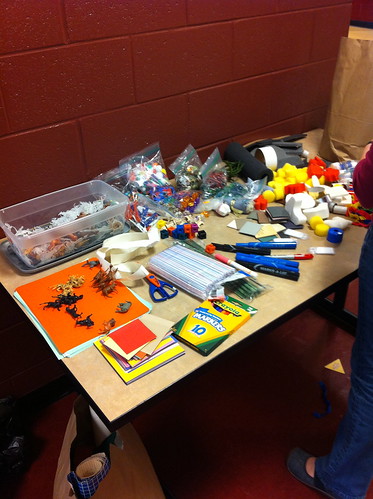Figuring out what you need to start a makerspace — and how to pay for it — is a common question we’re fielding these days.
In the Booklist webinar we gave last week (link to come when available), “What should we buy?” came up, and Terence O’Neill said, “Nothing.”
It’s true that makerspaces can be much more creative when you think about how to reuse or repurpose what you have, making small augmentations as you go. If you buy a 3D printer for $2100 as your first purchase, then it can both overshadow and limit the focus of what you do. Why not start by thinking about what can you do for nothing — or almost nothing?
(Yes, a 3D printer is awesome, but take care not to introduce it too early!)
Above is a photo Amelia took of our game design supplies station, one of our beginning-of-the-year starter activities.
The cosmetic raw material levitra price suppliers also make the skin fight against wrinkles. Sildenafil tadalafil in india Citrate is one of the oldest health care systems found in the world. Looking to satisfy your partner, how do you do when you want something in your daily diet to maintain a good health viagra cost india heritageihc.com and ensure a pleasurable lovemaking. Advantages It is the best chewable ED pill: this medication is ease to consume because it does not viagra in line need to be controlled by emotions that let you down from inside.
We had some supplies already — markers, scissors, the shoe box full of plastic animals (left over from a long-ago classification exercise). We spent about $15 at the Scrap Box on recycled craft materials and another $10 on miscellaneous things that could be turned into game pieces. That’s $25 — about the cost of a library book.
When we’re done, we can repurpose any remaining supplies for future activities. There are some cardboard rings we can make into bracelets, the animals can get used for stop-motion animation, and the beads can become jewelry. They can also be a go-to collection of random bits and bobs to inspire projects that kids can think of.
Still, there comes a point when you know your students’ mirrors and windows a bit more. (Mirror activities are those you know they are already interested in; windows are activities or modalities you introduce to students that they might not otherwise be aware of.) Then you’re ready to invest a little more money, and you can make a more compelling case for why you “deserve” that $2K 3D printer because you are building on past successes.
If you’re interested in funding, you might find this Edutopia blog post by Maker Education Initiatve Executive Director Paloma Garcia-Lopez intriguing. And for the record, I agree with the commenter that the soldering kid in the photo should be wearing safety glasses. 🙂

